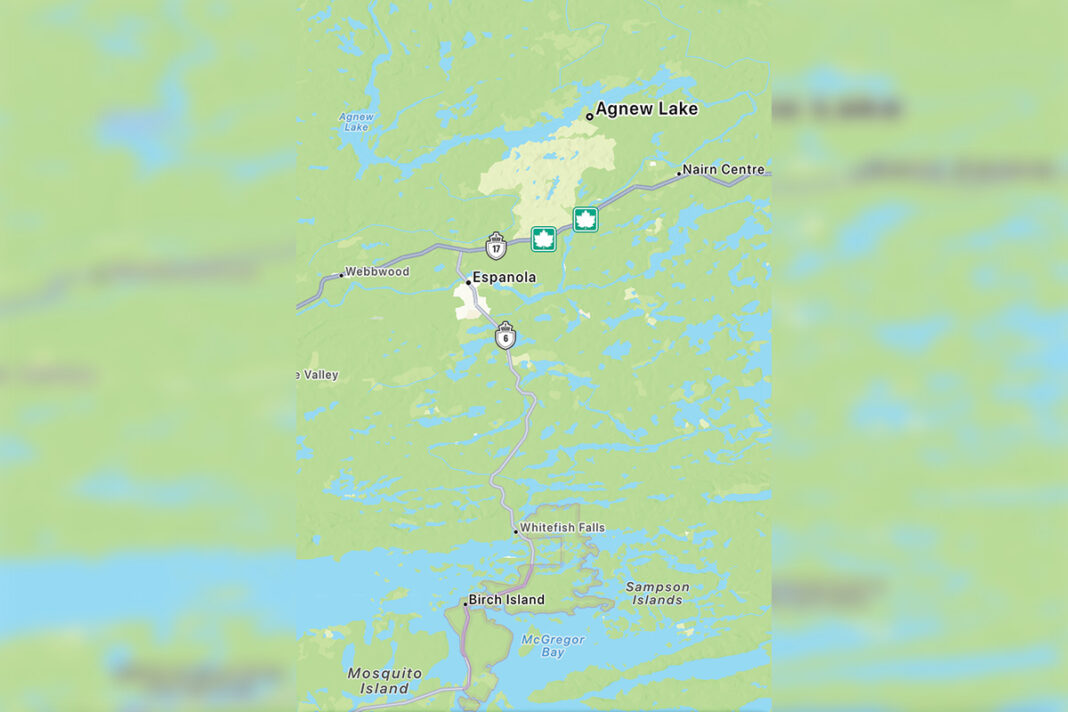Ontario Ministry of Mines plans to use Agnew Lake minesite as dumping ground
NORTH CHANNEL—The residents of Nairn and Hyman, a small township in Northern Ontario, were stunned to learn that Ontario plans to transport 40 tonnes of radioactive waste, including personal protection equipment (PPE), into their community. The waste, which has been stored for decades at an abandoned mill near Nipissing First Nation, is slated for disposal in the tailings facilities of the Agnew Lake Mine, an abandoned uranium minesite. The revelation has sparked outrage, fear, and a renewed focus on the dangers of contaminating watersheds with nuclear waste. It is being moved, in part, at the request of Nipissing First Nation.
The community discovered the plan only after noticing unusual activity on back roads leading to the long-dormant Agnew Lake Mine. The site, which had seen little use since the Ministry of Mines took over in the 1990s when it became the Agnew Lake Tailings Management Area, suddenly became the center of attention—and concern. “This project has been in the works for years. Why are we only finding out about it now?” demanded Belinda Ketchabaw, chief administrative officer of Nairn, during an emergency joint council meeting.
The lack of prior consultation or warning has left residents feeling betrayed. “They’re telling us it’s safe. Then why so much PPE? Why so many safety protocols?” Ms. Ketchabaw questioned, reflecting the community’s growing mistrust.
Chief Rodney Nawegahbow of Whitefish River First Nation expressed deep concerns about the environmental risks, particularly the contamination of local watersheds. “As ogimaa of Whitefish River First Nation, I firmly object to the development in the municipality. The risks of contaminating our water sources are too great to ignore,” he stated.
He elaborated on the potential impact, warning, “The material is being deposited at the highest point of land, adjacent to rivers and creeks that feed directly into Lake Agnew. This flows into the Spanish River and eventually into the North Channel of Lake Huron. We know from history that once a watershed is contaminated with radioactive material, the effects can be devastating and long-lasting.”
The chief’s concerns are well-founded. Studies have shown that radioactive waste can persist in the environment for thousands of years, posing a significant threat to ecosystems and human health. When radioactive materials enter a watershed, they can contaminate soil, water, and aquatic life, leading to bioaccumulation of harmful substances in the food chain. In many cases, the effects of such contamination are irreversible, leading to long-term ecological damage and public health crises.
During the emergency meeting, Darren Stephenson, an MTO area manager, tried to reassure the community by explaining that the niobium material being transported is less radioactive than the waste currently stored at the Agnew Lake facility. He suggested it could act as a cap for the existing tailings before being covered with topsoil and revegetated. However, these assurances did little to quell the fears of the skeptical council members and residents.
Nairn Councillor Trevor McVey was particularly vocal in his opposition, stating, “It’s like putting good garbage on bad garbage—we don’t want your garbage.” Mr. McVey, along with other councillors, expressed frustration over the province’s failure to communicate with local governments and the community, a move they believe only fueled public fear and distrust.
Mayor Amy Mazey shared her community’s apprehensions, noting, “We’re hearing conflicting things. On the one hand, it’s naturally occurring and low risk, yet the safety protocols seem intensive. It just leaves us with more questions.”
Chief Nawegahbow called for greater accountability and a more thorough consultation process with local Indigenous communities. “Our voices must be heard,” he urged. “This isn’t just about one community; it’s about protecting the environment and public health for everyone along the waterway. Once a watershed is contaminated, it can lead to widespread ecological destruction, affecting not just the immediate area but regions far downstream.”
The dangers of dumping radioactive waste into watersheds are well-documented. In many cases, the contamination leads to the poisoning of drinking water supplies, the destruction of aquatic habitats, and the exposure of communities to cancer-causing substances. The effects can last for generations, and the cleanup is often costly, difficult, and incomplete.
In a letter to Premier Doug Ford, Ms. Ketchabaw formally demanded an immediate halt to the project. The letter called for environmental and health impact assessments to be conducted by independent experts, with full transparency and community involvement. Ms. Ketchabaw also urged the province to engage in meaningful dialogue with local municipalities and First Nations.
A town hall meeting has been scheduled in the coming weeks to address the community’s concerns, but the damage to public trust may already be done. As the residents of Nairn and Hyman prepare to fight for their future, they are united by a common cause: protecting their land, their water, and their lives from the dangers of radioactive contamination.






